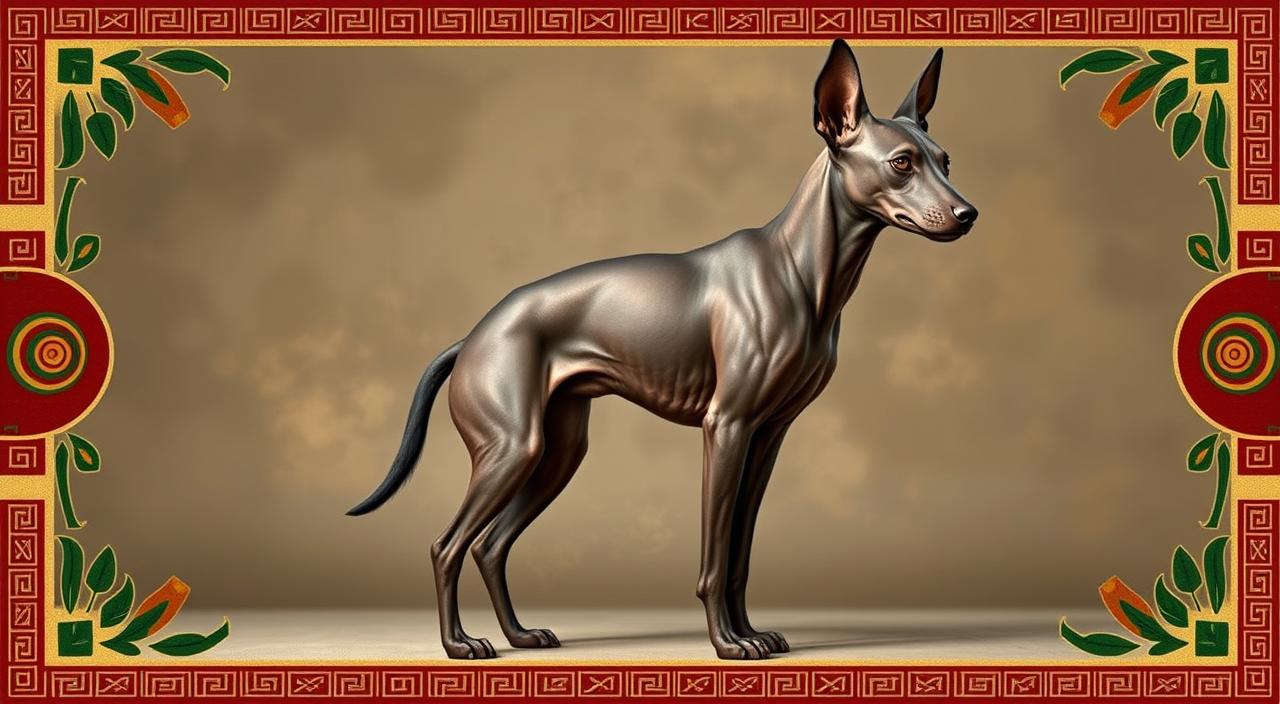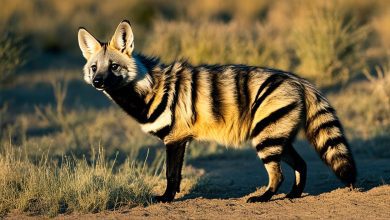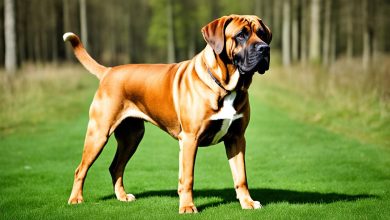The Xoloitzcuintli, or Xolo, is a living piece of history. This ancient breed has walked alongside humans for thousands of years. It’s more than Mexico’s national dog—it’s proof of the enduring human-canine bond.
Xolos have a unique, eye-catching appearance. Their hairless skin feels like warm leather to the touch. They come in three sizes: toy, miniature, and standard.
These dogs range from 9 to 26 inches tall. They can weigh anywhere from 10 to 55 pounds. Each size carries the same noble bearing and elegant shape.
The Xolo’s history dates back at least 3,000 years. It’s one of the oldest dog breeds in the Americas. Their hairlessness comes from a dominant trait that appeared long ago.
Interestingly, there’s also a coated variety of Xolo. These are born in the same litters as their hairless siblings.
Xolos are known for their calm and attentive nature. They make excellent companions and adapt well to different living spaces. Their moderate exercise needs suit various lifestyles.
These dogs have strong watchdog instincts. They thrive in small apartments and homes with yards alike.
The Xoloitzcuintli holds a special place in dog lovers’ hearts worldwide. Its story is one of survival and cultural significance. It truly showcases the unbreakable bond between humans and their canine friends.
Origins and History of the Xoloitzcuintli
The Xoloitzcuintli is an ancient Mexican breed with a 4000-year history. This Aztec dog was a hunter, guardian, and diplomatic gift. It played crucial roles in Mesoamerican civilizations.
Ancient Mesoamerican Roots
The Xoloitzcuintli’s roots go back to the Aztec empire. They were prized for their versatility as hunters, guards, and sentries. These dogs showed great adaptability and intelligence.
Aztec Cultural Significance
Aztecs saw the Xoloitzcuintli as sacred. Legend says god Xolotl made the breed from the Bone of Life. This belief made Xolos very important in Aztec society.
Near Extinction and Revival
Spanish conquistadors almost wiped out the Xoloitzcuintli. By the early 1800s, Xolos were only found in remote mountain villages.
After the 1910 Mexican revolution, efforts to save indigenous culture began. In the 1950s, scientists found ten Xolos to revive the breed.
Now, the Xoloitzcuintli is Mexico’s national dog. It stands as a symbol of the country’s enduring legacy and culture.
Physical Characteristics of the Xolo
The Xoloitzcuintli is a unique hairless dog breed from Mexico. It has a sleek body, almond-shaped eyes, and large bat-like ears. The Xolo’s smooth, wrinkled skin comes in black, gray, bronze, blue, and red.
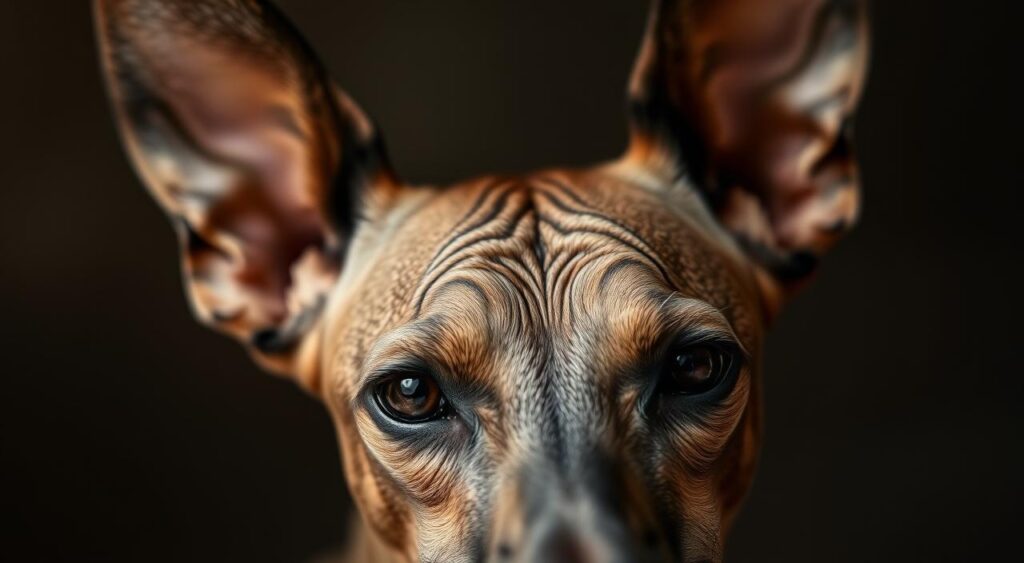
Xolos come in three sizes: toy, miniature, and standard. Toys are 10-14 inches tall, miniatures 14-18 inches, and standards 18-23 inches. Their weight ranges from 10 to 55 pounds.
Some Xolos have short, smooth fur. The hairless variety has tough, protective skin with sparse hair. This trait comes from a gene mutation, creating their dominant hairless feature.
“The Xoloitzcuintli’s appearance is truly one-of-a-kind, combining elegance with an air of mystery that has captivated dog lovers for centuries.”
Xolos need special skin care to stay healthy. Their wrinkled skin requires protection from the sun. With long necks and athletic builds, Xolos are graceful and agile.
The Xoloitzcuintli: Mexico’s National Dog
The Xoloitzcuintli is an ancient breed with roots over 3,500 years old. It holds a special place in Mexican culture. This unique dog has become a cultural symbol and Mexico’s national dog.
Cultural Heritage Status
In 2016, the Xoloitzcuintli became Mexico’s official national dog. This title confirmed its status as a cultural symbol. The Xolo represents a living link to Mexico’s pre-Columbian past.
Role in Modern Mexican Society
The Xoloitzcuintli plays a vital role in modern Mexican society. These dogs appear in art exhibitions and traditional celebrations. During Day of the Dead, Xolos often feature in decorations and artwork.
| Aspect | Role of Xoloitzcuintli |
|---|---|
| Cultural Events | Featured in exhibitions and celebrations |
| Art | Depicted in paintings, sculptures, and murals |
| Traditional Beliefs | Associated with spiritual and healing properties |
| National Identity | Represents Mexico’s indigenous heritage |
The Xoloitzcuintli’s journey from near-extinction to national dog status is remarkable. It shows the breed’s resilience and cultural importance. The Xolo inspires artists, fascinates historians, and captures hearts across Mexico and beyond.
Varieties and Sizes of Xoloitzcuintli
Xoloitzcuintli, or Xolos, offer a mix of unique traits. These ancient Mexican dogs come in different varieties and sizes. They suit various lifestyles and preferences.
Hairless and Coated Varieties
Xolos come in two main types: hairless and coated. Hairless Xolos have smooth skin with some hair tufts. Their skin color ranges from black to lighter shades.
Coated Xolos have a thin layer of fur all over their body. Both types can appear in the same litter due to genetics.
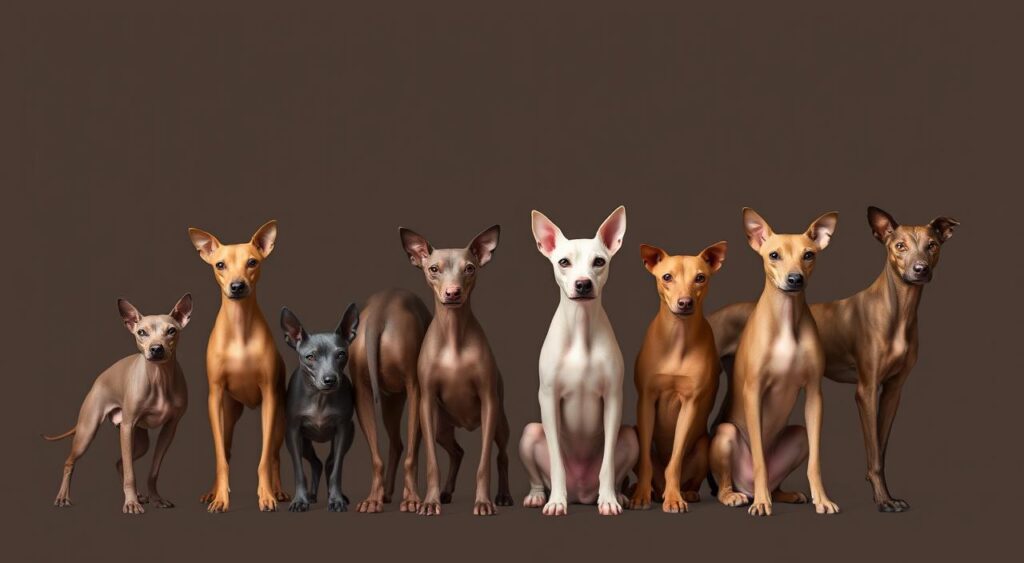
Toy, Miniature, and Standard Sizes
Xoloitzcuintli come in three sizes to fit different living spaces. Toy Xolos stand at 10-14 inches, perfect for apartments. Miniature Xolos range from 14-18 inches, offering a medium-sized option.
Standard Xolos measure 18-23 inches, ideal for those wanting a larger companion. This size variety makes Xolos suitable for many home types.
| Size | Height Range |
|---|---|
| Toy | 10-14 inches |
| Miniature | 14-18 inches |
| Standard | 18-23 inches |
The Xoloitzcuintli’s diverse traits make it a versatile breed. They can adapt to various homes and owner preferences. Their unique qualities appeal to many dog lovers.
Temperament and Personality Traits
Xoloitzcuintlis, or Xolos, are ideal companions with a unique temperament. They’re calm, attentive, and form strong bonds with their families. Their loyalty is hard to match.
Xolos make excellent watchdogs due to their intelligence and alertness. They react quickly to new sights and sounds. However, this trait can lead to excessive barking if not managed properly.
Xolos thrive on human companionship and often develop a special connection with one family member. They remain affectionate towards the entire household. Their strong attachment can sometimes result in separation anxiety.
“Xoloitzcuintlis are sensitive souls with a primitive streak. They demand attention and thrive on close companionship with their humans.”
Xolos generally get along well with children and other pets. However, they have a high prey drive. Early socialization is crucial for developing a confident and stable temperament.
Their independent nature and cleverness can lead to manipulative behaviors. Consistent training is necessary to establish respect and obedience.
| Trait | Description |
|---|---|
| Temperament | Calm, attentive, loyal |
| Intelligence | High, sometimes manipulative |
| Socialization Needs | Crucial for confidence |
| Prey Drive | High |
| Barking Tendency | Can be excessive |
Health and Lifespan of Xolos
Xoloitzcuintli, or Xolos, boast robust health and long lifespans. These Mexican hairless dogs typically live 13 to 18 years. They make excellent long-term companions for dedicated owners.
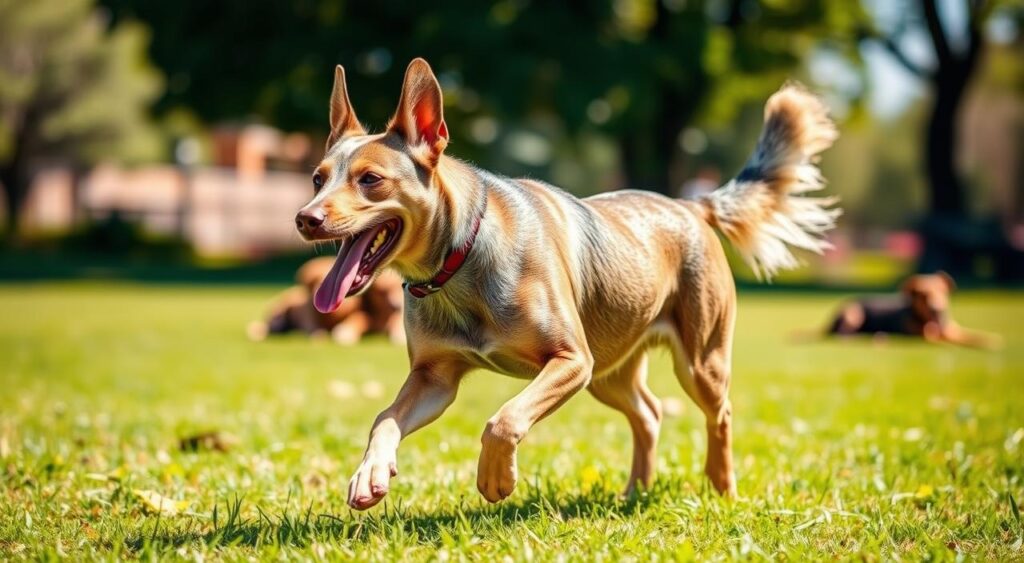
Common Health Concerns
Xolos are generally healthy but have some breed-specific issues. Their hairless skin requires special care due to sensitivity. Young Xolos may develop acne on their lips and muzzle.
Orthopedic conditions like hip dysplasia and patellar luxations can affect these dogs. Regular vet check-ups help monitor and prevent these issues.
Longevity and Care Requirements
Proper care ensures a long, healthy life for Xolos. Daily exercise of about 30 minutes is crucial. Their diet should follow AAFCO guidelines for optimal nutrition.
Puppies need three meals daily, while adults eat twice. Measured feeding prevents obesity, a common issue in Xolos.
- Regular bathing and skin hydration
- Consistent veterinary check-ups
- Dental care to prevent issues
- Mental stimulation through puzzle toys and activities
With proper care, Xoloitzcuintli can live up to 18 years. They form strong bonds with their families over time. Experienced dog owners are best suited to meet their unique needs.
Xoloitzcuintli Care and Maintenance
Xoloitzcuintli, or Xolos, are unique dogs with specific care needs. Their skincare routine is crucial, especially for hairless types. Regular bathing keeps their skin clean and healthy.
Xolos don’t usually need sunscreen due to their naturally protective skin. Young Xolos often face adolescent acne, but this typically resolves as they mature.
Xolos’ skin is tough and handles minor scrapes well. They are considered low-maintenance pets overall. Daily exercise is essential for Xolos’ well-being.
A brisk 45-minute to 1-hour walk keeps them fit and happy. They thrive on human interaction and dislike being alone for long periods.
| Aspect | Care Requirement |
|---|---|
| Skin Care | Regular bathing, no sunscreen needed |
| Exercise | 45-60 minutes daily walk |
| Diet | Balanced meals with kibble and meat |
| Socialization | Ongoing exposure to people and noises |
Proper nutrition is key for Xolos. A mix of quality kibble and meat off-cuts provides a balanced diet. Monitor their food intake carefully as Xolos can be prone to obesity.
Xolos respond well to positive reinforcement training. Early socialization is vital to prevent guarding behaviors. With proper care, these dogs can be wonderful companions for up to 18 years.
The Xolo’s Role in Aztec Mythology
The Xoloitzcuintli, or Xolo, is a sacred dog in Aztec mythology. This ancient breed dates back over 3,500 years. It played a key role in Mesoamerican spiritual beliefs and rituals.
Connection to the God Xolotl
The Xolo’s name comes from “Xolotl,” the Aztec god of fire and death. “Itzcuintli” means dog in Nahuatl. Xolotl, often shown as a monstrous dog, guided souls through the underworld.
This link highlights the Xolo’s importance in Aztec spiritual practices.
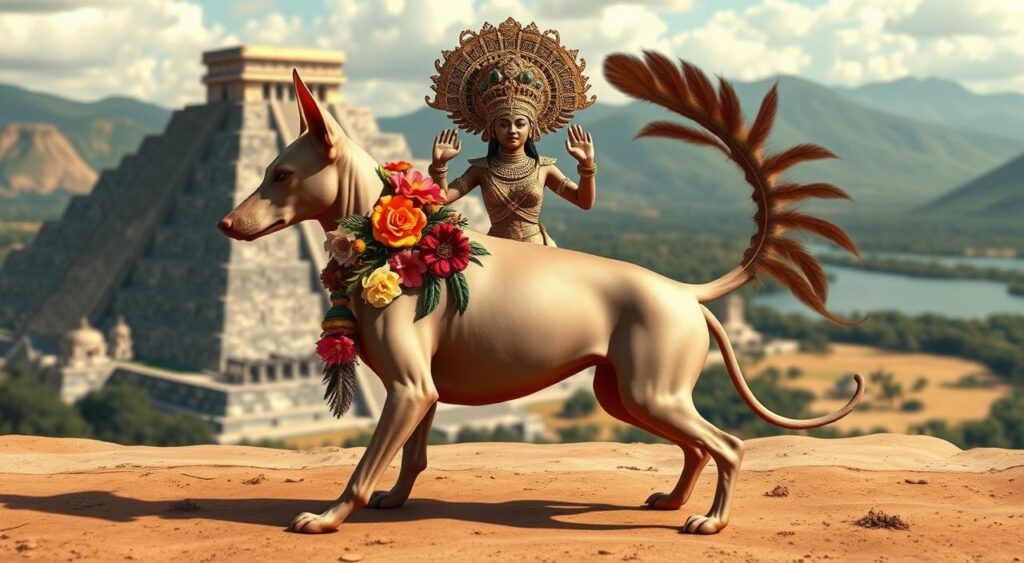
Spiritual and Mystical Beliefs
Aztecs thought Xolos had magical healing powers. They believed these dogs could cure asthma, toothaches, and rheumatism. Xolos were often buried with their owners to guide them in the afterlife.
“The Xolo was a protector against evil spirits and intruders, both in life and death.”
Archaeological finds support these beliefs. In western Mexico, most ancient burials include dog guide vessels. This shows how important Xolos were in guiding souls to the underworld.
| Aspect | Belief |
|---|---|
| Role in Afterlife | Guide souls to underworld |
| Healing Powers | Cure various ailments |
| Spiritual Protection | Ward off evil spirits |
The Xolo remains a symbol of Mexico’s rich cultural heritage. It connects ancient Aztec myths with modern spiritual beliefs.
Breeding and Genetics of Xoloitzcuintli
The Xoloitzcuintli, an ancient Mexican breed, has a fascinating genetic makeup. Its unique hairless trait comes from a FOXI3 gene mutation. This mutation is autosomal dominant, making it a key feature in Xolo breeding.
Xolo genetics follow a specific pattern. The hairless gene is dominant, while the coated gene is recessive. Breeding two hairless Xolos can result in non-viable offspring.
To avoid risks, breeders often pair a hairless Xolo with a coated one. This approach ensures healthier litters and maintains the breed’s characteristics.
Genetic testing is crucial for responsible Xolo breeding. It helps identify carriers of the hairless allele in coated dogs. The breed comes in three sizes: toy, miniature, and standard.
Hairless dogs have existed in Mexico for at least 3,000 years. Pre-Columbian cultures valued these dogs for rituals and companionship. Their selective breeding has preserved Xolos’ unique traits through centuries.
“The Xoloitzcuintli is a living piece of Mexican heritage, its genetics telling a story of ancient breeding practices and cultural significance.”
Efforts continue to preserve Xolos’ genetic diversity while maintaining their distinctive traits. As Mexico’s national dog, the Xoloitzcuintli represents the link between breeding and culture.
Xolos in Popular Culture and Art
The Xoloitzcuintli, Mexico’s ancient hairless dog, has left a lasting impact on Mexican art and culture. This unique breed has become a symbol of Mexican heritage. Artists and filmmakers have been inspired by Xolos for generations.
Representation in Mexican Art
Xolos have been a recurring theme in Mexican art for centuries. Famous artists like Frida Kahlo and Diego Rivera featured these dogs in their paintings. The breed’s smooth, hairless appearance and spiritual connections made it a popular subject.
Archaeological findings reveal the Xolo’s importance in ancient Mesoamerican cultures:
- Over 75% of Preclassic period burials in Colima, Nayarit, and Jalisco contain small ceramic vessels known as Colima Dogs.
- These vessels served as symbolic guides for the souls of the dead, emphasizing the Xolo’s spiritual role.
Appearances in Modern Media
Xolos have gained international recognition through various media appearances. The Disney/Pixar film “Coco” introduced millions to the breed through the lovable character Dante. This exposure has sparked new interest in Xolos, especially among those allergic to furry dogs.
| Xoloitzcuintli Characteristics | Details |
|---|---|
| Sizes | Standard and miniature |
| Coat Colors | Black, chocolate, red, bronze |
| Appearance | Smooth, hairless |
| Climate Adaptation | Can adapt to various climates |
| Care Requirements | Regular sun exposure needed |
| Temperament | Intelligent, loyal, affectionate |
The Xoloitzcuintli has gone from near-extinction to becoming a popular culture icon. This journey highlights its enduring appeal and cultural importance in Mexico and beyond.
Adopting and Owning a Xoloitzcuintli
The Xoloitzcuintli is a rare and unique dog breed. It ranks 139th in popularity according to the American Kennel Club. Dedicated breeders are the main source for adopting these ancient Mexican hairless dogs.
Xolos need indoor living and plenty of exercise. They thrive on a meat-rich diet. Their energy levels are moderate, but they have high exercise needs.
These dogs are affectionate and playful companions. They score 4 out of 5 for affection and 3 out of 5 for playfulness.
When adopting a Xolo, remember:
- They’re vocal (5/5) and watchful (4/5)
- Grooming needs are low (2/5)
- They’re heat-tolerant but sensitive to cold
- Lifespan: 11-14 years
Proper socialization is crucial for Xolos. About 60% of owners successfully integrate them with other pets. They adapt well and have few genetic health issues.
Xoloitzcuintli ownership can improve mental well-being and lower stress levels. Studies show dog owners often have lower blood pressure and visit doctors less frequently.
Make sure your lifestyle fits a Xolo’s needs before adopting. With good care and training, these dogs become loyal and loving pets.
The Future of the Xoloitzcuintli Breed
The Xoloitzcuintli, a rare Mexican hairless dog, is gaining popularity worldwide. With only 10,000 dogs globally, breeders are working hard to preserve its uniqueness. The breed’s future looks bright as efforts to safeguard its traits continue.
The Xoloitzcuintli has made great strides in international recognition recently. It entered Australia in 2009 and achieved ANKC breed recognition in 2010. The FCI, covering 83 countries, has set international standards for the Xolo.
In the United States, breeders like Richard Yenchesky have contributed significantly to the breed’s advancement. His dogs have achieved numerous titles and recognitions. These efforts have helped solidify the Xolo’s status worldwide.
The Xoloitzcuintli’s cultural importance and presence in popular culture boost its appreciation. Breeders focus on producing healthy dogs with good temperaments. This ancient breed’s journey from near extinction to global recognition is truly inspiring.
FAQ
What is the origin of the Xoloitzcuintli breed?
The Xoloitzcuintli, or Mexican Hairless Dog, is an ancient breed from the Americas. It dates back at least 3,000 years to Mesoamerican civilizations. Evidence suggests Xolos crossed the Bering Strait with early humans.
What are the physical characteristics of the Xoloitzcuintli?
Xoloitzcuintli have sleek bodies, almond-shaped eyes, and large bat-like ears. The hairless variety has tough skin with few coarse hairs. Coat colors include black, gray, bronze, blue, and red.
What is the significance of the Xoloitzcuintli in Mexican culture?
The Xoloitzcuintli became Mexico’s national dog in 2016. It’s a cultural heritage symbol of Mexico City. The breed appears in art, popular culture, and traditional celebrations like Day of the Dead.
What are the different varieties and sizes of the Xoloitzcuintli?
Xoloitzcuintli come in hairless and coated varieties. They have three sizes: toy, miniature, and standard. Both varieties can occur in the same litter due to genetics.
What is the temperament of the Xoloitzcuintli?
Xoloitzcuintli are calm, attentive, and loyal dogs. They bond closely with one family member but are affectionate to all. Xolos get along well with children and other dogs.
What are the common health concerns and lifespan of the Xoloitzcuintli?
Xoloitzcuintli are generally healthy but may have dental, skin, and joint issues. With proper care, their lifespan typically ranges from 13 to 18 years.
What are the care requirements for the Xoloitzcuintli?
Xoloitzcuintli need regular bathing, moisturizing, and sun protection for their skin. They require moderate exercise and adapt well to apartment living. Dental care is crucial due to their often incomplete teeth.
What role did the Xoloitzcuintli play in Aztec mythology?
In Aztec mythology, Xoloitzcuintli were linked to Xolotl, god of fire and death. Aztecs believed Xolos had healing powers and could guide souls through the underworld. They were often buried with owners as spiritual guides.
How does the breeding and genetics of the Xoloitzcuintli work?
Xoloitzcuintli breeding involves complex genetics due to the hairless trait. The hairless gene is dominant, while the coated gene is recessive. Breeding two hairless Xolos can produce both varieties.
How has the Xoloitzcuintli been represented in popular culture and art?
Xoloitzcuintli feature in Mexican art, including works by Frida Kahlo and Diego Rivera. They gained fame through Disney’s “Coco,” which featured a Xolo named Dante. The breed appears in exhibitions showcasing their cultural importance.
What should potential owners consider when adopting a Xoloitzcuintli?
Adopting a Xoloitzcuintli requires understanding their unique needs. Owners must provide proper skin care, dental attention, and consistent training. Xolos adapt well to various living situations but need affection and socialization.
What is the future outlook for the Xoloitzcuintli breed?
The Xoloitzcuintli’s future looks bright with growing worldwide recognition. Breeding programs focus on preserving genetic diversity and unique traits. Its cultural symbol status and media presence contribute to ongoing appreciation.
